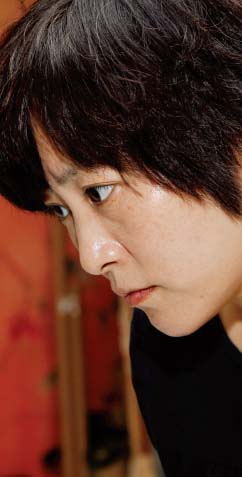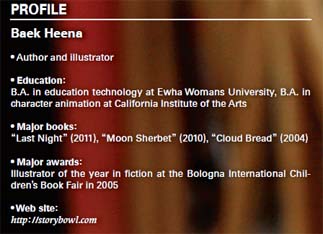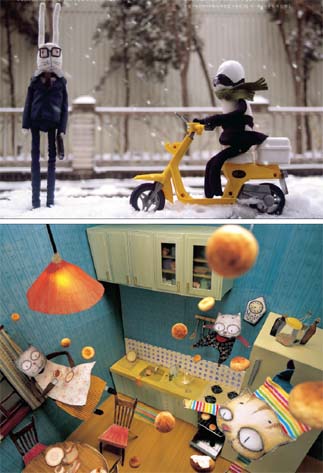Author revels in the independent life

Baek Heena, an author and illustrator of children’s books, is one of a few star authors in Korea. Provided by the author
Baek is the award-winning author of three children’s books, including the recently published “Last Night,” which centers on a dozen animals who all live in the same apartment. The book has been a best-seller at major bookstores in Korea since it was released earlier this year.
As an author and illustrator, Baek’s style differs greatly from illustrated children’s books that have flat drawings or rely heavily on repetition or onomatopoeia.
To bring her books to life, Baek makes or draws all of the objects in the photos that illustrate her books. Using every material imaginable, Baek creates miniature apartments, furniture, clothes and stuffed dolls. She has even baked miniature chocolate mud cakes. When everything is ready, she arranges the objects into a scene and photographs it, sometimes taking up to 1,000 shots to get the right image for a single page if necessary.

As of last week, seven out of the 10 best-selling children’s books at Kyobo Bookstore, the largest bookstore chain, were imported. The remaining three - “Last Night,” “Cloud Bread” and “Moon Sherbet” - were all written and illustrated by Baek.
“Cloud Bread” has sold about 500,000 copies so far both in and outside of Korea and is still ranked as the second best-selling children’s book in the nation.
The story follows two cats who are brother and sister on a rainy day as they find a chunk of cloud hanging low on a tree. They take it to their mother, who uses it to make bread. After a couple of bites of the bread, the siblings discover they can fly. They decide to give the cloud bread to their father, who had to skip breakfast and is on his way to work.
What makes the simple story so special is the way Baek presents it. The characters are paper cutouts that Baek dressed in actual costumes - such as the canary yellow raincoats and rubber boots the kids wear - before photographing them. The success of “Cloud Bread” prompted its publisher to develop the book into a commercial venture. It was made into a musical, animated cartoon series, iPhone application and even an actual bread product by one bakery franchise.
But watching this process was painful for Baek, who had no control over the commercialization process.
According to the contract she signed with her publishing company, she has no rights to the contents of her book, which is a common practice between publishers and new authors in Korea.
Yet it was the experience with “Cloud Bread” that led Baek to launch her own publishing company last year, and she says she is now able to appreciate the experience for the new direction it led her to take.
“If things hadn’t gone wrong with the contract, I may have worked for the publishing company on various projects, instead of doing what I want,” Baek said between sips of her cafe latte during a recent interview with the Korea JoongAng Daily.
Here are excerpts from the interview with Baek.
Q. Your new book “Last Night” is the second by your publishing company Storybowl. How do you feel about your decision to start your own company?
A. When “Moon Sherbet” (the first Storybowl publication) was released (last August), everything was new and difficult for me. I was busy selling books. (Laughs.) But I believe owning my own publishing house is the best form of work for me.
Before “Moon Sherbet,” I had a difficult time as an author - growing pains. Working with other people drained my confidence. I wasn’t sure of myself or whether I could continue working. That was when I decided to do everything myself. Working with a publisher is such a draining process - you have to constantly discuss, modify, persuade and negotiate with the company. Since starting my own company, I haven’t needed to go through that process, which has allowed me to enjoy every part of my work. Doing “Moon Sherbet” showed me that I can keep living as an author.
You had to deal with a controversy involving “Moon Sherbet” when an entertainment agency stole the title and gave it to a girl group. What was that like?
It was just four months after “Moon Sherbet” was published. What I worried about the most was that the image of my book would be tarnished because of the scandal. I didn’t want to lose another book (after “Cloud Bread”). I was also upset that children’s literature had been ignored and undermined by adults.
But last Christmas when I was working on “Last Night,” making stuffed animals, clothes and props, I was able to get through it by listening to Christmas carols. It was a huge comfort and a kind of therapy for me to work on “Last Night” during that difficult time.
In previous interviews, you’ve often talked about the contract you signed with the publisher of “Cloud Bread.” But were there things you were able to achieve with the book as well?
It was a huge blow to me. It was my first book, and for the past six years I’ve had to watch it be developed into various commercial products without my consent. Fortunately, it became an opportunity and I learned a lot about publishing. It also brought me recognition.
With “Moon Sherbet,” when I realized my book title had been stolen for the girl group, I felt responsible but I thought that I shouldn’t try to discourage other artists (from signing contracts) because I had already set a bad example (with “Cloud Bread”).
(Baek couldn’t take legal action against the entertainment agency because she only had the publishing industry copyright for the book and hadn’t applied for copyrights in other industries. That prompted Baek to apply for copyrights in different industries before “Last Night” was published. -Ed.)
It seems like you invent a different style every time you release a new book. In your folktale about a grandmother who boils red bean paste porridge and a tiger who attempts to eat her, you produced beautiful dolls using hanji (traditional Korean paper). Why did you choose to do that?

Baek Heena’s newest book, “Last Night,” centers on a dozen animal characters that live in the same apartment. As with all of her books, the animals, clothes and props were made by Baek. Provided by the author. Baek’s first book, “Cloud Bread,” became a sensation when it was published in 2004. The book instantly topped the children’s book best-seller list, which is still dominated by imported books. [JoongAng Ilbo]
Writing is often a reflection of one’s personality. Your heartwarming stories make me wonder what your childhood was like. Was it similar to that of the cat siblings in “Cloud Bread”?
My father used to play acoustic guitar to put us to sleep and my mother baked bread, which later became a motif for “Cloud Bread.” My mother also made clothes for me and my two other sisters all the time. I was a happy child until I went to elementary school. (Laughs.) I think about happy childhood memories whenever I’m having a hard time.
You seem to have a talent for making the food in your books look appetizing. It’s a pity that we can’t buy moon sherbet (ice cold sherbet made from the moon). In “Last Night,” the three-layer chocolate mud cake looked particularly beautiful. Does that mean you’re a good cook?
No! (Laughs.) I hardly spend any time outside my studio. I just fantasize about beautiful and delicious-looking food.
What do children’s books mean to you?
It’s a very limited form of storytelling. There are certain requirements - the book should be bound and there should be a cover page. I think those limits make the work even more interesting. It can be difficult to purchase paintings because they are expensive, but if you buy a picture book you can own beautiful drawings and look at them anytime, anywhere.
What’s next for you?
My daughter has a cute and interesting story to tell. So I’m thinking about developing it into a book and working with her on it. I’m also working on an iPhone application that is a picture book for women. My dream is to have a two-story place where children can come and read books on the first floor and my studio is on the second floor.
By Sung So-young [so@joongang.co.kr]
Related Korean Article[중앙일보]
“일상 속 추억을 구체화하도록 도와주세요”
상상력과 일상 생활을 연결 시켜보자
“아이의 머릿속에 떠오른 작은 장면을 놓치지않고 구체화하도록 도와주세요. 창의적 스토리를 끌어내는 시작입니다.” 상상력이 가득한 데뷔작 구름빵으로 40만부 넘는 판매고를 올린 백희나 작가는 두 아이의 엄마이기도 하다. 그는 아이의 상상력을 확장시키고 창의적 스토리를 만들도록 유도하는 비결로 ‘구체화’를 꼽았다. 아이의 상상에 세부적인 요소를 추가해 다음 단계의 상상을 더해나갈 수 있도록 유도하는 방식이다.
먼저 아이의 머릿속에서 자유롭게 떠오르는 영상을 설명해보게 한다. 집 안이나 학교에서 일어났던 소소한 일상 속 추억도 좋다. 그는 “아이가 특정 장면을 설명하면 그 순간이 낮인지 밤인지, 조명은 어느 정도의 밝기였는지, 집바깥의 날씨는 어떠했는지 물어보라”며 “이러한 습관이 익숙해지면 새로운 이야기를 만들어 낼 때 자연스럽게 주변의 환경과 같은 세부적 요소도 함께 떠올리게 돼 이야기의 완성도가 높아진다”고 말했다.
그는 상상력이 일상 생활과 긴밀히 연결될때 다른 사람들의 공감을 자아낼 수 있다고 생각한다. 미국 LA의 산 정상에서 봤던 발 아래 깔린 구름의 풍경도 처음엔 백 작가의 머릿속에 스쳐 지나가는 생각일 뿐이었다. “그때 ‘비오는 날에 무거워진 구름이 땅까지 내려오면 누가 줍게 되지 않을까’ ‘주운 구름을 반죽해 빵으로 만들면 어떨까’ 식의 상상이 꼬리를 물기 시작했어요. 구름빵의 시작이었죠.” 하늘을 나는 판타지성 스토리는 아침식사를 거른채 출근한 아빠를 찾아나서는 주제와 결합되면서 현실에서 일어날 수 있는 일로 다듬어졌다. 주인공 고양이 남매(홍비·홍시)의 이름을 딸과 아들의 이름으로 따서 넣자 백 작가의 가족과도 가까워진 그림책이 탄생했다.
고정관념 탈피하도록 유도해야
고정관념은 상상력을 키우는 데 방해가 되는 요소 중 하나다. “어른들만 갖고 있는 문제가 아니냐”는 질문에 백 작가는 고개를 저었다. “아이들에게 집을 그려보라고 해보세요. 대부분 뾰족한 지붕에 격자 창문이 달린 서양식 가옥을 그린답니다. 자기가 살고 있는 아파트를 그리지 않아요. 외국동화 속에서 본 그림이 집이라는 고정관념을 가지고 있는 거죠.”
이처럼 현실이 아닌 고정관념에 기반한 상상력은 세부 묘사를 하거나 구체적인 상상을 이어나가기 어렵다. 실제 일상 속에서 경험한 것이 아니기 때문이다. 백 작가는 “아이도 모르는 고정관념을 그림 속에서 찾아낸 뒤, 진짜 현실 속 그림을 그리게 해보라”며 “그것을 바탕으로 새로운 생각을 뻗어나갈 때 상상력이 날개를 달게 된다”고 강조했다. 한번도 가본 적 없는 독일마을을 그릴 때보다, ‘○○아파트’ 속 인물들의 생활을 묘사할 때 훨씬 더 풍부한 이야기를 풀어나간다는 설명이다.
시각적 고정관념을 벗어나는 연습도 중요하다. 한 가지 장면을 여러 각도로 상상해보는 연습은 공간감각을 키우고 새로운 이야기의 소재를 만들어준다. 백 작가는 ‘보이는대로 그려보기’ 놀이를 권했다. 방 안의 특정한 사물을 놓고 눈에 보이는 그대로 그려보게 하는 방법이다. 천장에서 바라본 사다리꼴 모양의 냉장고와 정면에서 바라본 냉장고의 모습을 그려 나열한 뒤 비교해보는 식이다. 그림 등을 그린 뒤엔 형태를 오려 입체모형으로 만들어봐도 좋다.
부모가 실수하기 쉬운 부분도 있다. 마구잡이식 상상력을 강요하는 지도방식이다. 무조건 새로운 상상을 강조하면 아이들은 난데없는 사물이나 기존의 이야기와 전혀 관계없는 인물을 등장시킬 때가 있다. 그것이 새로운 것이라 오해하는 것이다. 백 작가는 “전래동화 속이야기에 갑자기 로봇을 등장시킨다면 분명히 그에 대한 이유가 자기 나름대로 있어야 한다”며 “한 가지 분위기나 원하는 이미지를 목표로 정하게 하면 이야기가 일관성을 갖고 흐르는데 도움이 된다”고 말했다.










with the Korea JoongAng Daily
To write comments, please log in to one of the accounts.
Standards Board Policy (0/250자)